Reichstag assault
Berlin was one of the largest cities in the world, yielding in Europe by area (88 thousand hectares) only to Greater London. From east to west, it stretches 45 km, from north to south - more than 38 km. Most of its territory was occupied by gardens and parks. Berlin was the largest industrial center (2 / 3 of the electrical industry in the country, 1 / 6 engineering, many military enterprises), a highway and railroad site in Germany, a major inland shipping port. To Berlin converged 15 railway lines, all roads were connected by a ring road within the city. There were up to 30 stations in Berlin, more than 120 railway stations and other railway infrastructure facilities. Berlin had a large network of underground communications, including the underground (80 km of tracks).
The city districts were divided by large parks (Tiergarten, Treptow Park, etc.), which occupied most of Berlin. Greater Berlin was divided into 20 districts, 14 of them were external. Inland areas (within the district railway) are most densely built up. The layout of the city was distinguished by straight lines, with a large number of areas. The average height of buildings is 4-5 floors, but by the beginning of the Berlin operation, most of the houses were destroyed by the Allied bombing. aviation. The city has many natural and artificial obstacles. Among them, the Spree River, up to 100 meters wide, a large number of canals, especially in the southern and northwestern parts of the capital. There are many bridges in the city. City roads ran along steel overpasses and embankments.
The city began to prepare for defense from the beginning of 1945. In March, a special defense headquarters was formed in Berlin. The city’s defense command was headed by General Reiman, 24 of April was replaced by the commander of the 56 tank corps Helmut Weidling. The imperial commissioner for the defense of Berlin was Josef Goebbels. The propaganda minister was a gauleiter of Berlin, responsible for civilian authorities and preparing the population for defense. General management of the defense was carried out by Hitler himself, he was assisted by Goebbels, Bormann, the Chief of the General Staff of the Ground Forces, General Hans Krebs, the chiefs of the personnel department of the German Army, Wilhelm Burgdorf, and the Secretary of State Werner Naumann.
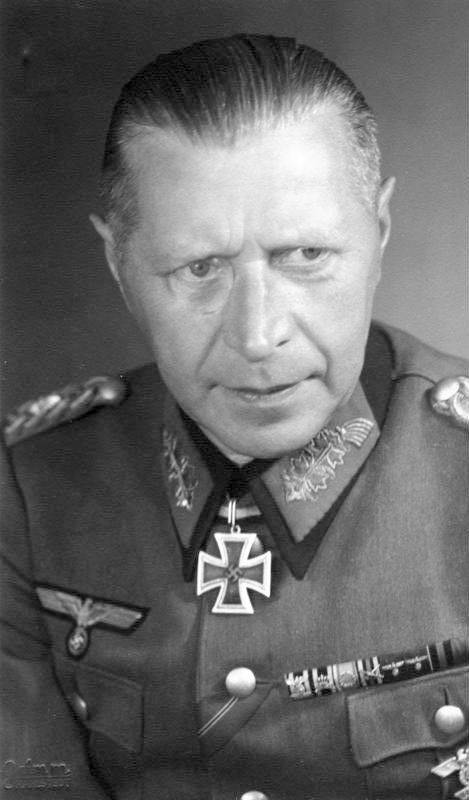
Commander of Defense and the last commandant of Berlin, Helmut Weidling
Weidling received Hitler's order to defend himself until the last soldier. He decided that the division of the Berlin region into 9 defense sectors was unsuitable and focused on the defense of the eastern and southeastern outskirts, where the most combat-ready units of the garrison were located. The strengthening of the 1st and 2nd sectors (eastern Berlin) was directed tank Division "Munich". The 3rd defense sector (southeastern part of the city) was reinforced by the “Nordland” tank division. The 7th and 8th sectors (northern part) were reinforced by the 9th parachute division, and the 5th sector (southwest) - by units of the 20th tank division. The most preserved and combat-ready 18th Motorized Division was left in reserve. The remaining sections were defended by less efficient troops, militias, various units and subunits.
In addition, Hitler had great hope for outside help. Steiner’s army group was to break through from the north, the 12th Army of Wenck approached from the west, and the 9th Army from the southeast. Grand Admiral Dönitz was supposed to bring the naval forces to the rescue of Berlin fleet. On April 25, Hitler ordered Dönitz to suspend, if necessary, all other tasks of the fleet, surrender the enemy strongholds and transfer all available forces to Berlin: by air - to the city itself, by sea and by land to the fronts fighting in the capital area. Air Force Commander Colonel General Hans Jürgen Stumpf received an order to introduce all available aviation forces for the defense of the capital of the Reich. The directive of the German High Command of April 25, 1945 called on all forces to abandon "against Bolshevism", to forget about the Western Front, not paying attention to the fact that the Anglo-American troops would capture a significant territory of the country. The main task of the army was to release Berlin. Extensive propaganda was conducted among the troops and among the population, people were intimidated by the "horrors of Bolshevism" and called for a fight to the last possible opportunity, to the last bullet.
Berlin was prepared for a long defense. The most powerful part of the Berlin Defense District was the center of the city, where the largest government buildings, the main railway stations and the most massive urban buildings were located. It housed most of the government, military bunkers, the most developed network of metro and other underground utilities. Buildings, including those destroyed by bombing, were prepared for defense, became strongpoints. Roads and intersections were closed with powerful barricades, some of which were difficult to destroy even with the fire of large caliber guns. Streets, lanes, intersections and squares were under oblique and flanking fire.
Stone buildings were turned into strong strongholds. In buildings, especially in the corner ones, machine gunners, machine gunners, faustnik, guns with a caliber from 20 to 75 mm were placed. Most of the windows and doorways were sealed, left only under the embrasures. The composition and number of garrisons of such strong points was different, and depended on the tactical value of the object. The most serious points defended garrisons up to the battalion. Approaches to such a stronghold were covered with firing means, which were located in neighboring buildings. Observers, spotters, machine gunners and machine gunners were usually located on the upper floors. The main fire equipment was placed on the first floors, in semi-basement and basement rooms. There, under the protection of thick ceilings, most of the garrison was located. Several such fortified buildings, usually uniting a whole block, formed a knot of resistance.
Most of the firing means were located in the corner buildings, the flanks were covered with powerful barricades (3-4 thickness of a meter), which were constructed from concrete blocks, bricks, trees, trams and other vehicles. Barricades mined, covered with infantry and artillery fire, prepared trenches for faunters. Sometimes tanks were buried behind the barricades, then a loophole was made in the barricade, and a trench was prepared under the lower hatch for storing ammunition connected to the nearest basement or porch. As a result, a large tank survivability was achieved, in order to reach it, it was necessary to break the barricade. On the other hand, the tank was devoid of maneuver, could fight with enemy tanks and artillery only in the strip of its street.
The intermediate buildings of the resistance centers were defended by smaller forces, but the approaches to them were covered with fire weapons. In the rear part of the resistance node, heavy tanks and self-propelled guns were often dug into the ground in order to fire on the Soviet troops and stop the infiltration of our infantry into their rear. Underground utilities were widely used - metro, bomb shelters, sewers, drainage canals, etc. Many of the strongholds were connected by underground passages, when our troops broke into one object, German garrisons could go along them to another. The exits from the underground structures, which went in the direction of our troops, mined, filled up or set up posts from machine gunners and grenade throwers. In places, at the exits, reinforced concrete caps were installed. They had machine gun nests. They also had underground tunnels and, under the threat of a capture or undermining of a reinforced concrete cap, his garrison could leave.
In addition, thanks to a developed network of underground communications, the Germans could attack the rear of the Soviet troops. In our sent a group of snipers, machine gunners, machine gunners and grenade throwers, who, thanks to a good knowledge of the terrain, could cause serious harm. They ambushed, shot armored vehicles, vehicles, gun crews, destroyed single soldiers, officers, messengers, destroyed communication lines, and could quickly roll up and retreat through underground passages. Such groups were very dangerous.
A feature of the city center was the presence of a significant number of reinforced concrete shelters. The largest were reinforced concrete bunkers that contained a garrison of 300-1000 people, and several thousand civilians. The Luftwaffe anti-aircraft towers were large ground concrete bunkers, which were placed around 30 guns in caliber up to 150 mm. The height of the military turret reached 39 meters, the wall thickness was 2-2,5 meters, the roof thickness was 3,5 meters (this made it possible to withstand a bomb hit weight up to 1000 kg). The tower had 5-6 floors, each battle platform had 4-8 anti-aircraft guns that could fire at ground targets. In Berlin, there were three such military towers - in the Tiergarten, Friedrichshain and Humboldthain Park. In total, the city had about 400 reinforced concrete bunkers. The presence of a developed underground cable-telephone communication network made it possible to maintain command and control of the troops even during the most difficult battles, when most of the communications equipment was disabled.
The weak point of the garrison in Berlin was providing it with ammunition and food. The capital was provided with reserves for one month of the siege. However, due to the danger of air strikes, stocks were scattered around the suburbs and outskirts of Berlin. There are almost no warehouses in the center of the city. The rapid decline of the margins led to the loss of most of the warehouses. As the environment ring narrowed, the supply became less and less. As a result, in the last days of the battle for Berlin, the situation with the supply of German troops became catastrophic.
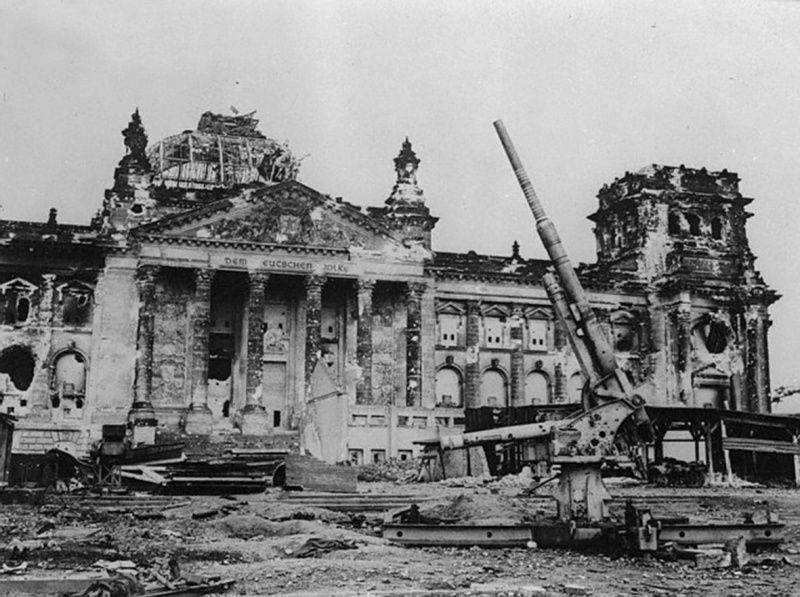
Broken German 88-mm anti-aircraft gun FlaK 37 in the defeated Reichstag
Soviet tactics
The battle in the city required specific methods of combat, which differed from the field conditions. The front was all round. Soviet and German troops could only be separated by a carriageway, a square, a wall of a building, or even a floor. So, on the first floor could be our troops, and in the basement and on the upper floors - the Germans. However, the Soviet troops already had a rich successful experience in street fighting. The experience of the battles in Stalingrad and Novorossiysk, replenished in Poznan, Breslau, Budapest, Königsberg and other cities, was useful.
The main form of urban combat, already tested in other cities, was practically independent actions of assault groups and detachments, reinforced by firing means. They could find weak spots and gaps in the enemy's defenses, storm buildings turned into strong points. Soviet attack aircraft tried to move not along the main thoroughfares, well prepared for defense, in between. So reduced damage from enemy fire. Assault detachments moved from building to building, through yards, breaks in the walls of buildings or fences. The assault detachments cut the enemy's defense into separate parts, paralyzing the command. They could independently penetrate deeply into enemy defenses, bypassing the most powerful nodes of resistance. They were aimed at artillery, aircraft, additional forces of infantry and tanks. This allowed the Soviet troops to maintain high rates of attack, isolate entire urban areas, and then "clean up" them from the Nazis.
The combat order of the assault detachment was usually built as follows: the infantry was supported by tanks and self-propelled guns; they, in turn, were guarded by arrows controlling lofts, window and door openings, basements; tanks and infantry supported self-propelled guns and artillery. The infantry fought with the enemy’s garrisons, cleared the Nazis from their homes and neighborhoods, and carried out their close anti-tank defenses, primarily from the grenade throwers. Tanks and self-propelled guns took over the task of destroying enemy fire weapons. Then the infantry completed the cleanup of the area, destroying the surviving soldiers of the enemy.
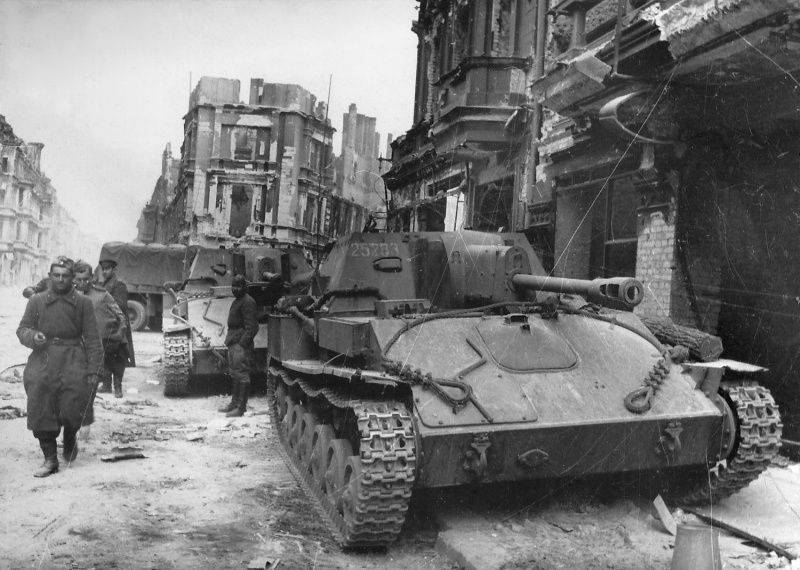
Soviet SAU SU-76M on a street in Berlin
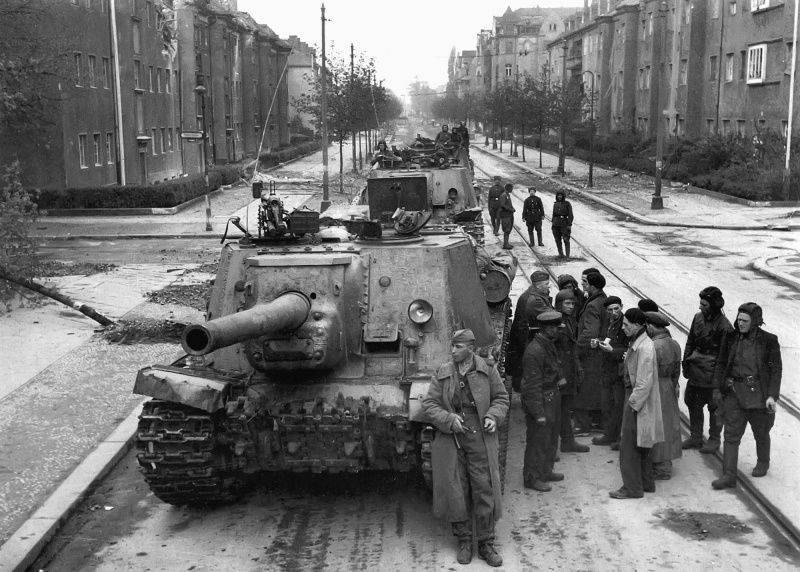
Column of Soviet SAU ISU-122 on a street in Berlin
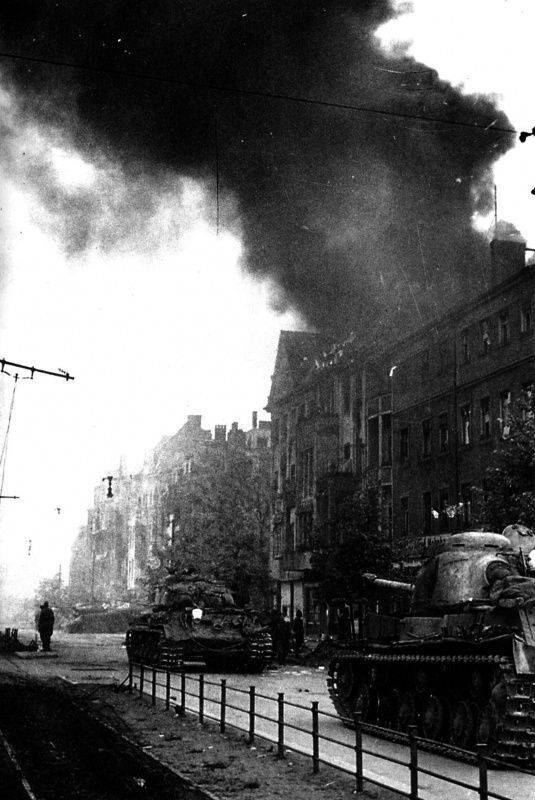
Soviet heavy tanks IS-2 on a street in Berlin
The assault force consisted of several assault groups, a fire group and a reserve. Assault groups directly stormed the building. The fire group included artillery, including large-caliber guns, mortars, tanks and self-propelled guns. The reserve made up a rifle platoon or company, replaced the existing assault groups, consolidated success and reflected the enemy’s counterattacks. Attacking a fortified building, the assault group was usually divided into several parts: one part destroyed the Nazis in the basement and semi-basement with flamethrowers, grenade launchers, grenades and bottles of combustible mixture; another group led the sweep of the upper floors of the enemy’s submachine gunners and snipers. Both groups were supported by the firing group. Sometimes the situation demanded reconnaissance by force when the smallest units — 3-5 — of the most brave and trained soldiers imperceptibly penetrated into the building, which the Germans defended and caused a commotion with a sudden attack. Then the main forces of the assault group were connected.
Usually, at the beginning of each day, an artillery preparation of up to 20-30 minutes was held before the attack of assault detachments and groups. It was attended by divisional and corps tools. They fired from closed positions at previously reconnoitered targets, enemy firing positions and possible troop concentrations. Fire artillery imposed throughout the quarter. Directly during the storming of strongholds, volleys of M-31 and M-13 rocket launchers were used. "Katyusha" also beat at enemy targets in the depths of his defense. In the course of urban battles, rocket launchers were widely used for direct fire. This was done directly from the ground, from the simplest devices, or even from window openings and breaks. So they destroyed the barricades or destroyed the defense of buildings. With a small range of fire - 100-150 meters, the M-31 projectile pierced a brick wall with a thickness of up to 80 cm and broke inside the building. When several missiles hit the building, the house was severely destroyed, and the garrison was killed.
Artillery in the assault squads fired at enemy buildings directly. Under the cover of artillery and mortar fire, attack aircraft were selected to the enemy strongholds, broke into them, entered the rear. Artillery played a huge role in street fighting. In addition, in the assaults of enemy objects used tanks and self-propelled guns that crushed the enemy's fire weapons. Heavy ACS could destroy barricades, create breaks in buildings, walls. A large role was played by sappers who, under the cover of fire, dragged explosives, destroyed obstacles, created gaps, removed mines, etc. When storming some objects, they could put up a smoke screen.
When a barricade arose on the way of the assault detachment, Soviet soldiers first seized the buildings that adjoined the obstacle, then large-caliber guns, including self-propelled guns, smashed the blockage. If the artillery could not do it, then the sappers under the cover of fire and smoke screen dragged charges of explosives and undermined the obstacle. Tanks broke through the passages made, guns were dragged behind them.
It is also worth noting that flame-incendiary was widely used in street battles. Storming the house, the Soviet soldiers widely used Molotov cocktails. Divisions of high-explosive flame throwers were used. Flamethrowers were a very effective means of struggle when it was necessary to “smoke out” the enemy from the basement or set fire to the building and force the Nazis to retreat. Infantry smoke equipment was also widely used to install small masking and blinding smoke screens.
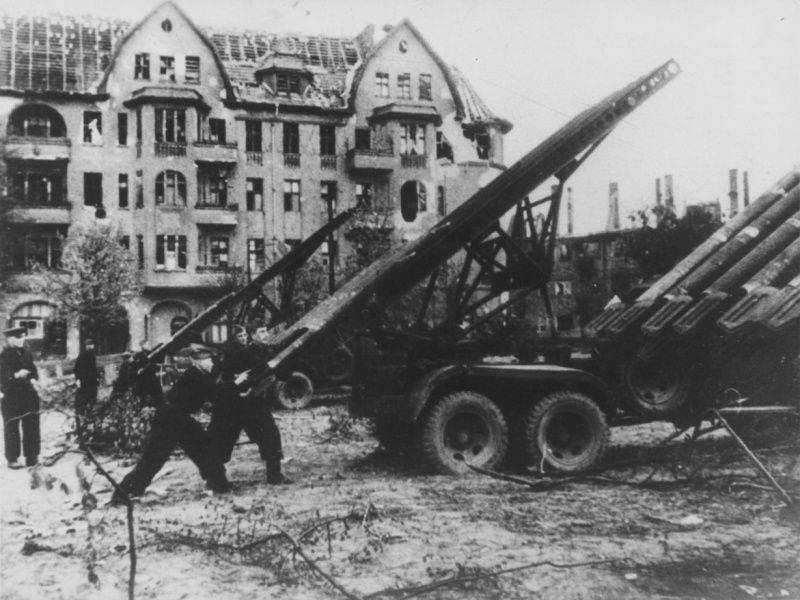
Soviet artillerymen are preparing for salvo rocket mortar BM-13 "Katyusha" in Berlin
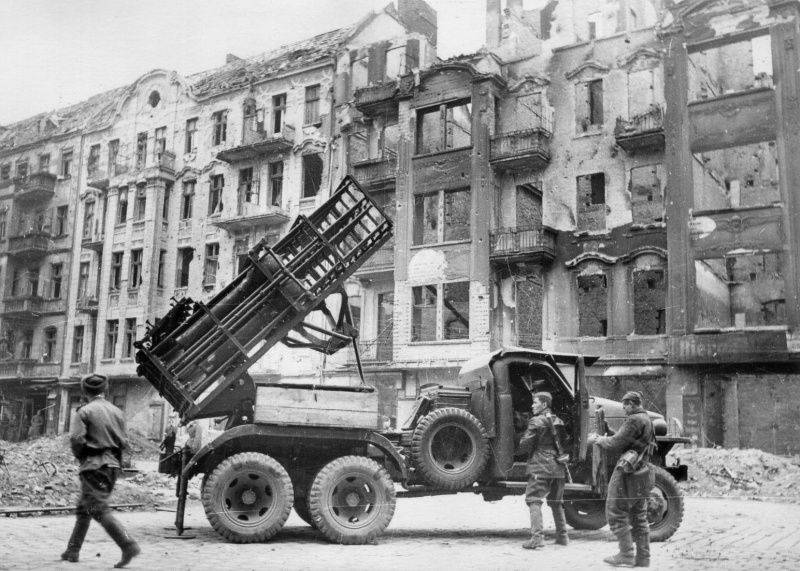
Guards rocket mortar BM-31-12 in Berlin

Soviet tanks and other equipment at the bridge over the River Spree in the Reichstag area. Under this bridge, Soviet troops under fire from the defending Germans marched to storm the Reichstag. The photo tanks, EC-2 and T-34-85, SAU IMS-152, guns
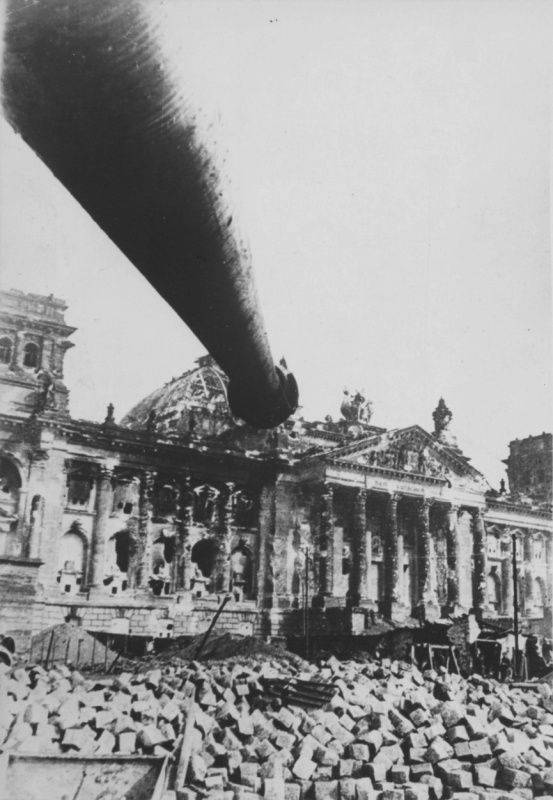
The barrel of a Soviet heavy tank, the EC-2, aimed at the Reichstag building
Fighting in other directions. Breakthrough to the city center
The battle for Berlin was fierce. Soviet troops suffered heavy losses, in the rifle companies left on 20-30 fighters. Often it was necessary in battalions to reduce three companies into two, in order to increase their combat capability. In many regiments, three battalions were reduced to two. The advantages in manpower of the Soviet troops during the storming of the German capital was insignificant - about 460 thousand people against 300 thousand German troops, but there was an overwhelming superiority in artillery and armored vehicles (12,7 thousand mortar guns, 2,1 thousand "Katyushas" 1,5 thousand tanks and self-propelled guns), which allowed to smash the enemy defenses. With the support of artillery and tanks, the Red Army, step by step, went to victory.
Before the start of the battles for the central part of the city, the bombers of the 14 and 16 air armies launched powerful strikes against the complex of government buildings and the main resistance centers of Berlin. During Operation Salut 25 on April, the 16 Air Force's airplanes carried out two massive raids on the Reich capital, 1486 aircraft participated in them, which dropped 569 tons of bombs. Artillery bombarded the city with powerful shelling: from 21 in April to 2 in May, around 1800 thousand artillery shots were fired at the capital of Germany. After strong air and artillery strikes, the storming of the central districts of Berlin began. Our troops forced water obstacles - the Teltow Canal, the Berlin-Spandauer Canal, the Spree and Dahme Rivers.
April 26 Berlin group was divided into two separate parts: in the city itself and a smaller part, in the suburbs of Wannsee and Potsdam. On this day, the last telephone conversation took place between Hitler and Jodl. Hitler still hoped to “save” the position to the south of Berlin and ordered the 12 Army, together with the troops of the 9 Army, to sharply turn the front of the offensive to the north in order to alleviate the position of Berlin.
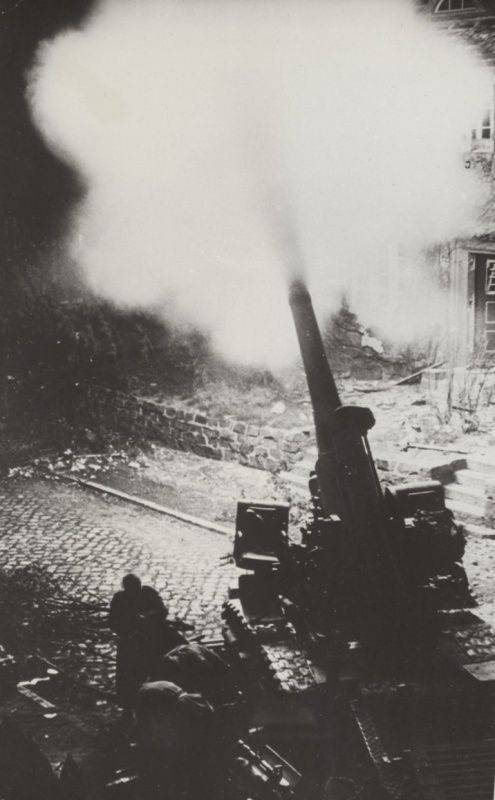
Soviet 203-mm howitzer B-4 firing in Berlin at night
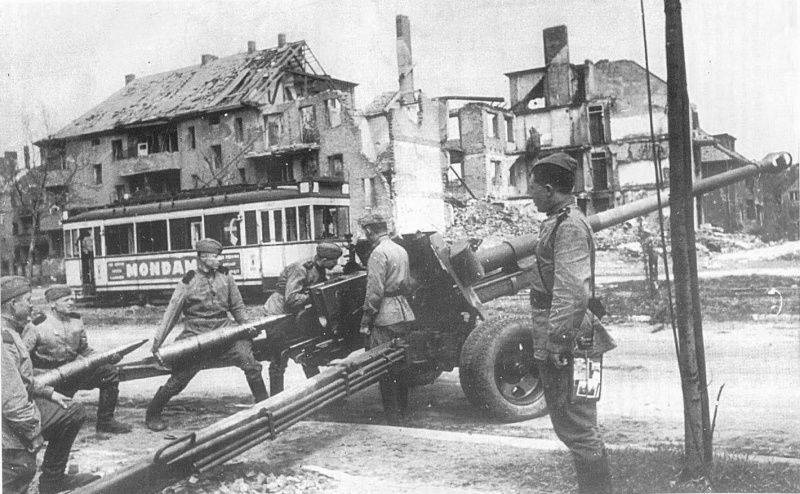
The calculation of the Soviet 100-mm guns BS-3 firing at the enemy in Berlin
The Germans fought fiercely. On the night of April 26, the command of the surrounded Frankfurt-Guben group surrounded by the southeast of the capital, following the order of the Führer, formed a strong grouping of several divisions to break through the battle formations of the 1 of the Ukrainian Front by the army. On the morning of April 12, the Germans launched a counterattack, delivering a strong blow to the 26 and 28 th guards armies. The Germans breached the gap and went to the city of Baruth. But here the enemy was stopped by the 3-division of the 395-th army, and then the Germans attacked parts of the 13-th, 28-th Guards and 3-th Guards Tank armies. Aviation played a major role in defeating the enemy. Bombers and ground attack almost without interruption attacked the battle formations of the German group. The Germans suffered great damage in manpower and technology.
At the same time, our troops repelled the attack of the Wenk 12 Army, which attacked in the Belitz-Trieyenbritzen strip. Parts of the 4 Guards Tank Army and the 13 Armies parried all enemy attacks and even advanced to the west. Our troops captured part of Wittenberg, south of it forced the Elbe and captured the city of Pratau. Intense battles with the 12-th army and the remnants of the 9-th army, trying to escape from the environment, lasted several more days. The troops of the 9 Army a few were able to advance west, but only small isolated groups could break in from the “boiler”. By early May, the surrounded enemy group was completely destroyed.
The goerly group did not succeed either. She was unable to overturn the left flank of the 1 of the Ukrainian Front and break through to Spremberg. By the end of April all the attacks of the enemy troops were repulsed. German troops moved to the defense. The left wing of the 1 of the Ukrainian Front could go on the offensive. The offensive of the 2 of the Byelorussian Front also developed successfully.
27 April, our troops continued the offensive. The Potsdam group of the enemy was destroyed and Potsdam was taken. Soviet troops captured the central railway junction, tied the battle for the 9 sector of the Berlin defensive area. In 3 hour. On the night of April 28, Keitel spoke with Krebs, who said that Hitler was demanding immediate assistance to Berlin, according to the Führer, “at most 48 hours of time” remained. In 5 hour. In the morning, communication with the imperial office was broken. 28 April, the territory occupied by German troops was reduced to 10 km from north to south and to 14 km - east to west.
Berlin, the Germans especially stubbornly defended the 9 sector (central). From the north, this sector was covered by the river Spree, in the south was the Landwehr Canal. Most of the bridges were destroyed by the Germans. The bridge Moltke was covered with anti-tank obstacles, well protected. The banks of the Spree and the Landwehr Canal were clad in granite and rose to the 3 meter, providing additional protection for the German troops. In the central sector there were several powerful defense units: the Reichstag, the Krol-Opera (the building of the imperial theater), the building of the Ministry of Internal Affairs (the Gestapo). The walls of the buildings were very powerful, they were not pierced by shells of large-caliber guns. The walls of the lower floors and basements reached 2-meter thick, and were additionally reinforced with earth mounds, reinforced concrete and steel rails. The square in front of the Reichstag (Königsplatz) was also prepared for defense. Here were located three trenches with machine-gun nests, they were connected with the communication lines with the Reichstag. Approaches to the square were covered with anti-tank ditches with water. The defense system included 15 reinforced concrete pillboxes. Anti-aircraft guns were located on the roofs of buildings, on the grounds and in the Tiergarten park, field artillery positions. The houses on the left bank of the Spree were turned into strong points that protected the garrisons from platoon to company. The streets leading to the German parliament were barricaded, obstructed and mined. A powerful defense was created in the Tiergarten. To the south-west of the central sector adjoined the knot of defense in the Zoological garden.
The central region was defended by soldiers from various elite units of the SS and the battalion of the Volkssturm. On the night of April 28, three companies of seamen from the maritime school in Rostock dropped into the central sector from transport aircraft. In the area of the Reichstag, the 5 garrison defended thousands of soldiers and officers, supported by three artillery battalions.
The beginning of the storming of the Reichstag
Leading persistent battles, the Soviet troops to 29 April cleared most of the city from the Nazis. In some parts of the Soviet troops broke through the defense of the central sector. From the north, units of the 79 rifle corps were attacked by S. N. Perevertkin of the 3 th shock army. By the evening of April 28, the troops of the 3 Shock Army, having captured the Moabit area, broke through to the Reichstag area, at the Moltke Bridge. Here lay the shortest path to the Reichstag.
At the same time, units of the 5 shock, 8 Guards and 1 Guards Tank armies of the 1 Belorussian Front made their way to the center from the east and southeast. 5-I shock army captured Karlhorst, forced the Spree, cleared from the Germans the Anhalt station and the state printing house. Her troops broke through to Alexanderplatz Square, Wilhelm's Palace, the Town Hall and the Imperial Chancellery. The 8-I Guards Army moved along the southern coast of the Landwehr Canal, approaching the southern part of Tiergarten Park. 2-I Guards Tank Army, seizing the area of Charlottenburg, advancing from the north-west. The troops of the 3 Guards Tank Army and the 28 Army of the 1 Ukrainian Front made their way to the 9 sector from the south. The 47 Army of the 1 Belorussian Front, part of the forces of the 4 Guards Tank and 13 armies of the 1 Ukrainian Front firmly secured the external front of the surroundings of Berlin from the west.
The position of Berlin became completely hopeless, the ammunition was running out. The commander of the defense of the Berlin region, General Weidling, offered to save the troops and gather the remaining forces for a breakthrough to the west. General Krebs supported the idea of a breakthrough. Hitler was also repeatedly offered to leave the city himself. However, Hitler did not agree with this and ordered to continue the defense of the last bullet. He considered that it makes no sense for the troops to break from one “cauldron” into another.
The troops of the 79th Rifle Corps were unable to immediately take the Moltke Bridge. However, on the night of April 29, decisive actions of the advanced battalions of the 756th Infantry Regiment of the 150th Infantry Division under the command of Major General Vasily Shatilov (the battalion was commanded by Captain S. Neustroev) and the 380th Infantry Regiment of the 171st Infantry Division under the command of Colonel Alexei The villains (the battalion was commanded by Senior Lieutenant Konstantin Samsonov) the bridge was occupied. The Germans fought heavy fire and launched counterattacks. The situation was aggravated by the fact that the right bank of the Spree River had not yet been completely cleared of German troops. Soviet soldiers occupied only Alt-Moabit-Strasse, which overlooked the bridge and the surrounding neighborhoods. At night, the Germans launched a counterattack, trying to encircle and destroy our troops, who crossed to the left bank of the river and destroy the Moltke bridge. However, enemy attacks were successfully repelled.
Units of the 380 regiment, 525 regiment of the 171 division, 756 regiment of the 150 division, tanks and escort weapons, flame throwers of the 10 th separate motorized flame thrower battalion were deployed to the left bank of the Spree. On the morning of April 29, after a short fire attack, our troops continued the offensive. All day long our soldiers fought hard for the buildings adjacent to the Spree, it was especially difficult to take the building of the Ministry of Internal Affairs (our soldiers called it "Himmler's house"). It was only after the introduction of the second echelon of the 150 Division, the 674 Infantry Regiment, into battle, that the situation was reversed in our favor. "House Himmler" took. Several more buildings were captured, and the Soviet soldiers were in 300-500 meters from the Reichstag. But immediately develop success and take the Reichstag did not work.
Soviet troops conducted preliminary preparations for the assault on the Reichstag. Intelligence has studied the approaches to the building and the enemy's fire system. In the area of the fighting pulled new firing means. All new tanks, self-propelled guns and guns were shipped to the left bank of the river. Several dozen guns, including 200- and 300-mm howitzers, were pulled up to the closest distance in 152-203 meters from the building. Prepared jet installations. We brought ammunition. From the best warriors formed assault groups for hoisting the flag over the Reichstag.
Early in the morning of April 30, the bloody battles resumed. The Nazis repulsed the first attack of our troops. Selected SS units fought to the death. In 11 hour. 30 min. after the artillery barrage our troops went on a new assault. A particularly stubborn battle was fought in the offensive zone of the 380 regiment, led by the chief of staff, Major VD Shatalin. The Germans repeatedly turned into violent counterattacks that went into melee. Our troops suffered serious losses. Only at the end of the day the regiment made its way to the anti-tank ditch at the Reichstag. A heavy battle was going on in the offensive zone of the 150 Infantry Division. Units 756-th and 674-th infantry regiments made their way to the channel in front of the Reichstag and lay there under heavy fire. There was a pause, which was used to prepare a decisive assault on the building.
In 18 hour. 30 min. under the cover of artillery fire, our soldiers rose to a new attack. The Germans could not stand it, and our soldiers broke through to the building itself. Immediately on the building appeared in various forms and size of red banners. One of the first to appear was the flag of the 1 th battalion of the 756 th battalion of the junior sergeant Peter Pyatnitsky. Enemy bullet hit the Soviet soldier on the steps of the building. But his flag was picked up and set over one of the columns of the main entrance. Flags of Lieutenant R. Koshkarbayev and Private G. Bulatov from the 674 Regiment, Sergeant M. Eremin and Private G. Savenko from the 380 Regiment, Sergeant P. S. Smirnov and Private N. Belenkov and L. Somov from 525-th regiment, etc. Soviet soldiers once again showed mass heroism.
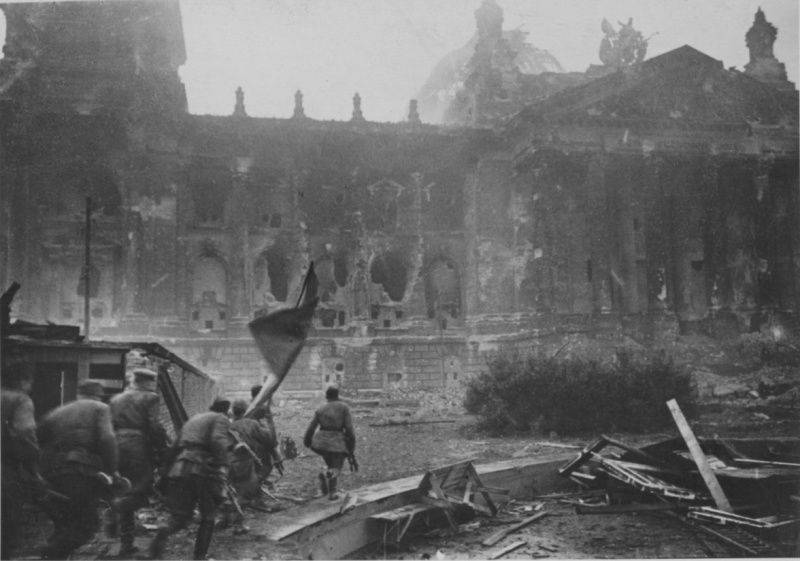
Soviet assault group with a banner moving to the Reichstag
The battle for the interior began. The Germans continued to put up stubborn resistance, defending every room, every corridor, stairwell, floors and basements. The Germans even went on the counter. However, it was impossible to stop our fighters. Until Victory there are very few. Captain Neustroyev’s headquarters was deployed in one of the rooms. The assault group under the command of sergeants G. Zagitova, A. Lysimenko and M. Minin broke through to the roof and secured the flag there. On the night of May 1, a group of fighters under the command of Lieutenant A. P. Beresta received the task of hoisting a banner on the Reichstag, which was handed over by the Military Council of the 3 shock army. Early in the morning, Alexei Berest, Mikhail Egorov and Meliton Kantaria set off the Victory Banner - the assault flag of the 150 Rifle Division. The assault on the Reichstag continued until May 2.
On the same day, when Soviet flags appeared on the Reichstag (April 30), Adolf Hitler committed suicide.
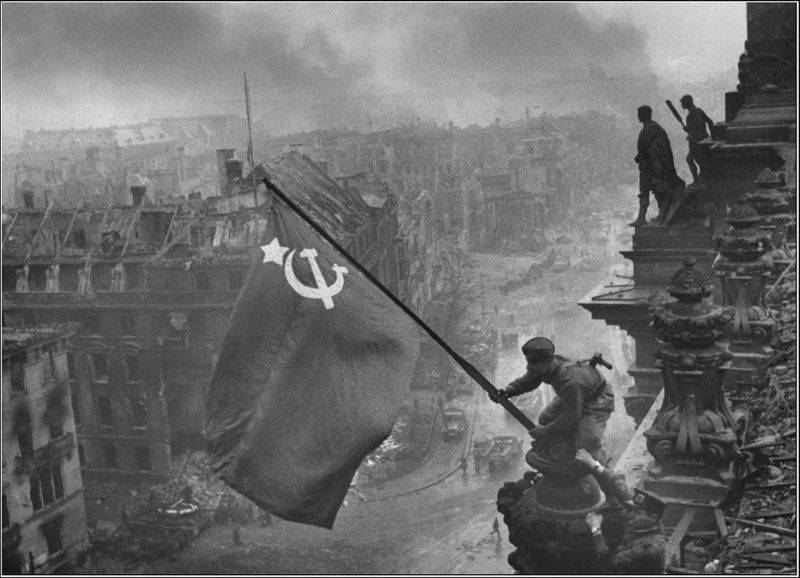
Victory Banner over the Reichstag
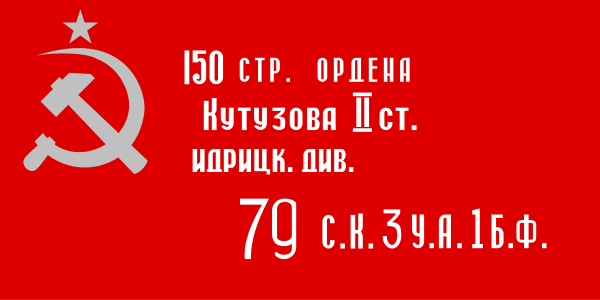
Assault Flag of the 150 Order of Kutuzov, II Class, of the Idritsa Rifle Division
To be continued ...
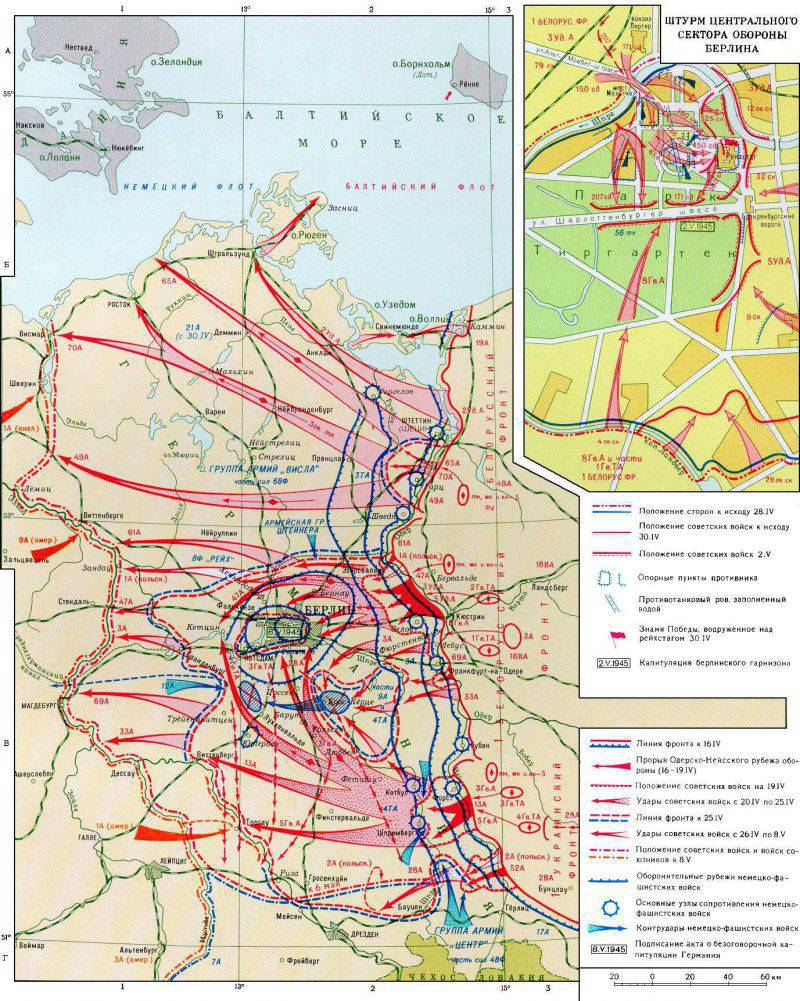
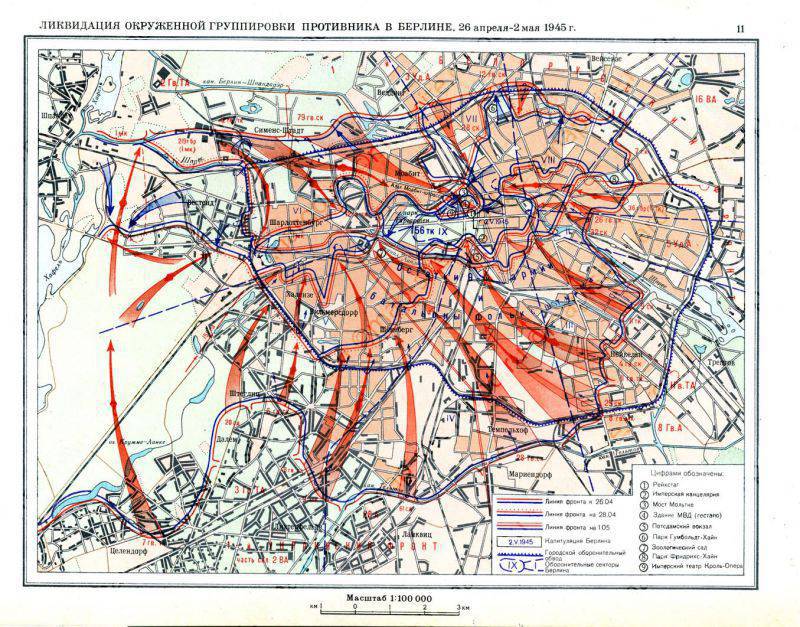
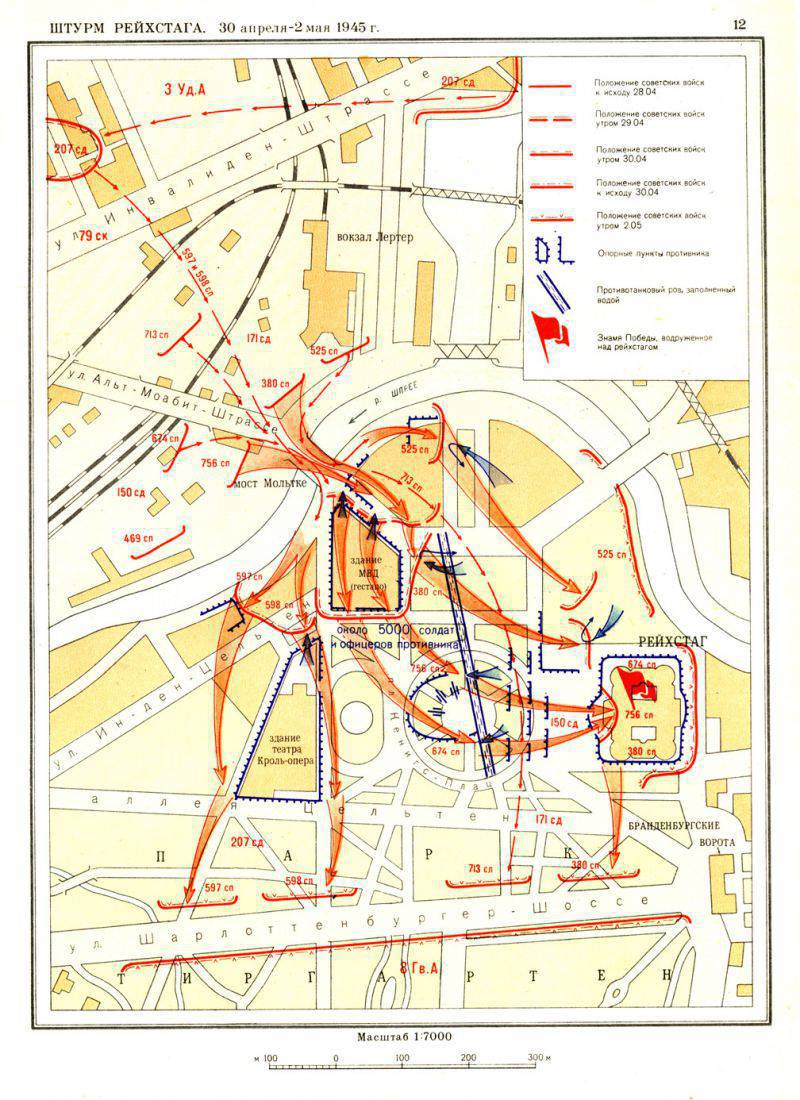
Information